郑州大学研究生全英语教学课程立项协议书
郑州大学研究生教学管理暂行办法
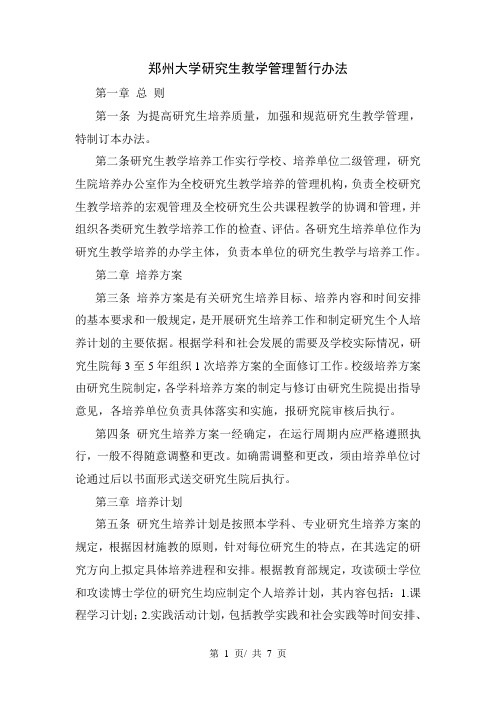
郑州大学研究生教学管理暂行办法第一章总则第一条为提高研究生培养质量,加强和规范研究生教学管理,特制订本办法。
第二条研究生教学培养工作实行学校、培养单位二级管理,研究生院培养办公室作为全校研究生教学培养的管理机构,负责全校研究生教学培养的宏观管理及全校研究生公共课程教学的协调和管理,并组织各类研究生教学培养工作的检查、评估。
各研究生培养单位作为研究生教学培养的办学主体,负责本单位的研究生教学与培养工作。
第二章培养方案第三条培养方案是有关研究生培养目标、培养内容和时间安排的基本要求和一般规定,是开展研究生培养工作和制定研究生个人培养计划的主要依据。
根据学科和社会发展的需要及学校实际情况,研究生院每3至5年组织1次培养方案的全面修订工作。
校级培养方案由研究生院制定,各学科培养方案的制定与修订由研究生院提出指导意见,各培养单位负责具体落实和实施,报研究院审核后执行。
第四条研究生培养方案一经确定,在运行周期内应严格遵照执行,一般不得随意调整和更改。
如确需调整和更改,须由培养单位讨论通过后以书面形式送交研究生院后执行。
第三章培养计划第五条研究生培养计划是按照本学科、专业研究生培养方案的规定,根据因材施教的原则,针对每位研究生的特点,在其选定的研究方向上拟定具体培养进程和安排。
根据教育部规定,攻读硕士学位和攻读博士学位的研究生均应制定个人培养计划,其内容包括:1.课程学习计划;2.实践活动计划,包括教学实践和社会实践等时间安排、任务要求及考核方式;3.学位论文工作计划;4.对研究生学习过程和各培养环节的其它要求。
第六条根据各学科研究生培养方案的要求,在导师或指导小组的指导下,于入学后1周内,由研究生本人在郑州大学学位与研究生教育综合管理系统完成培养计划的制订,经导师审核提交后,由所在院(系)打印备案。
研究生必须在导师的指导下,严格按照培养计划,修满所有课程学分,通过各培养环节。
第七条研究生所选课程一经确定,一般不得改动。
河南高等教育教学改革研究项目立项申请书【范本模板】
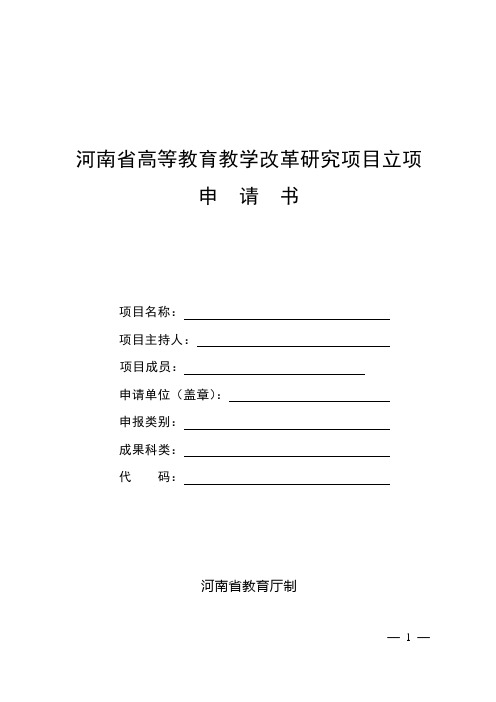
河南省高等教育教学改革研究项目立项申请书项目名称:项目主持人:项目成员:申请单位(盖章):申报类别:成果科类:代码:河南省教育厅制—1 —一、简表—2 —二、立项依据:(项目的意义、现状分析)—3 —三、项目实施方案及实施计划—4 ——5 ——6 ——7 ——8 —四、教学改革基础—9 ——10 ——11 —五、经费预算六、学校推荐意见—12 —七、省教育厅组织专家组评审意见八、省教育厅审批意见—13 ——14 —附件6《河南省高等教育教学改革研究项目立项申请书》填报事宜说明《河南省高等教育教学改革研究项目立项申请书》是省级教改立项申请、评审、批准的主要依据,必须严格按规定的格式、栏目及所列标题如实、全面填写.1.项目名称:应准确、简明地反映出项目的主要内容和特征,字数(含符号)不超过35个汉字。
2.申报类别:指项目推荐为省级重点研究项目和省级研究项目。
3.成果科类:指哲学、经济学、法学、教育学、文学、历史学、理学、工学、农学、医学、管理学.4.代码:组成形式为:abcdef,其中:ab:项目所属科类代码:哲学—01,经济学—02,法学—03,教育学—04,文学—05,历史学—06,理学-07,工学-08,农学—09,医学—10,管理学—12,艺术学—13。
c:项目人员为一个人填1,两个人填2,三个人填3,四个人填4,五个人填5,六个人填6,七个人填7,八个人填8,九个人填9,10人以上填0。
d:项目属普通教育填1,成人教育填2。
—15 —e:项目属高职教育填1,本科教育填2,研究生教育填3。
f:项目内容属综合研究填1,人才培养模式改革填2,课程教学改革填3,实践教学改革填4,教学手段与教学方法改革填5,教育教学管理填6。
5.《申请书》等书写、打印格式:(1)《申请书》可用原件按1:1比例复印(去掉“附件3”字样)。
纸张一律用A4纸,竖装,两面印刷.文字及图表应限定在高245毫米、宽170毫米的规格内排印,左边为装订边,宽度不小于25毫米,正文内容所用字型应不小于5号字。
校级教学改革项目立项名单

基础医学融合性实验教学课程体系改革的探讨
薛长贵
重点
10000
23
基础医学院
《基础神经生物学》教材建设
张朝
重点
10000
24
基础医学院
现代医学教育中医学遗传学课程体系的综合改革
郑 红
重点
10000
25
药学院
综合性大学药学教育课程体系改革与实践
张振中
重点
10000
26
医学检验系
临床检验诊断学实验课教学统筹管理的探索与实践
化学类专业创新人才培养模式的研究
廖新成
重点
10000
序号
所在单位
项目名称
项目负责人
项目级别
资助金额(元)
32
信息工程学院
《大学计算机基础与应用》精品课程建设的研究与实践
王贺明
重点
10000
33
信息工程学院
提高工科生毕业设计(论文)质量的研究
程明
重点
10000
34
信息工程学院
软件人才培养模式的研究与实践
144
历史学院
中国佛教史入门
李晓敏
非资助
145
信息管理系
图书馆学专业教学方法和教学手段的改革方案实施
97
化学系
化学实验教学中心开放实验室运行模式研究
何占航
一般
5000
98
化学系
《计算机辅助化学研究与设计》多媒体课件开发与课程建设
徐顺
一般
5000
99
化学系
《高等有机化学》三维立体教学模式的研究与实践
陶京朝
一般
5000
100
教高〔2012〕1185号

河南省教育厅教高…2012‟1185号河南省教育厅关于公布2012年度河南省高等学校精品资源共享课程及双语教学示范课程名单的通知各高等学校:按照《河南省教育厅关于做好2012年度河南省高等学校教学工程项目申报工作的通知》(教高…2012‟639号)要求,经学校申报、资格审查、网络评审、会议终审和网上公示,评选出了郑州大学《化工原理》、郑州牧业工程高等专科学校《动物细胞培养技术》等2012年度河南省高校精品资源共享课程75门(本科50门、高职25门)以及郑州大学《高分子化学》等双语教学示范课程20门,现予以公布(附件)。
— 1 —河南省高等学校精品资源共享课程和双语教学示范课程视为职务作品。
课程所在高等学校和主讲教师被视为同意将其上网内容的非商业性使用权自然授予全省各高等学校。
课程所在高校要提供建设经费,保证课程网站畅通,免费开放课程资源,并不断更新上网内容。
我厅将不定期对省精品资源共享课程和双语教学示范课程进行复核,根据复核情况决定是否保留或取消其荣誉称号。
用户可登录“河南省高校精品课程建设网”(网址为),免费浏览河南省高等学校精品资源共享课程和双语教学示范课程。
未经著作权人许可,任何人不得将课程内容用作以营利为目的的活动。
各高等学校要加强政策引导,加大精品资源共享课程和双语教学示范课程经费投入,推进优质课程资源的建设与共享,进一步巩固教学工作的中心地位,不断提高教育教学质量。
附件:1.2012年度河南省高等学校精品资源共享课程名单2.2012年度河南省高等学校双语教学示范课程名单二○一二年十二月十九日— 2 —附件12012年度河南省高等学校精品资源共享课程名单— 3 —— 4 —— 5 —— 6 —— 7 —— 8 —附件22012年度河南省高等学校双语教学示范课程名单— 9 —— 10 —— 11 —。
来华硕士留学生全英教学探索与实践——以《旅游市场营销》课程为例
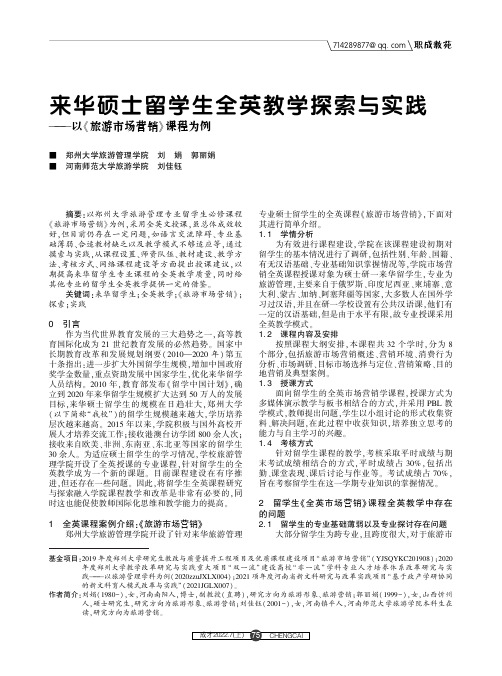
714289877@ 职成教苑基金项目:2019年度郑州大学研究生教改与质量提升工程项目及优质课程建设项目 旅游市场营销 (YJSQYKC 201908);2020年度郑州大学教学改革研究与实践重大项目 双一流 建设高校 非一流 学科专业人才培养体系改革研究与实践 以旅游管理学科为例(2020zzuJXLX 004);2021项年度河南省新文科研究与改革实践项目 基于政产学研协同的新文科育人模式改革与实践 (2021JGLX 007)㊂作者简介:刘娟(1980-),女,河南南阳人,博士,副教授(直聘),研究方向为旅游形象㊁旅游营销;郭丽娟(1999-),女,山西忻州人,硕士研究生,研究方向为旅游形象㊁旅游营销;刘佳钰(2001-),女,河南镇平人,河南师范大学旅游学院本科生在读,研究方向为旅游营销㊂来华硕士留学生全英教学探索与实践以‘旅游市场营销“课程为例ʏ㊀郑州大学旅游管理学院㊀刘㊀娟㊀郭丽娟ʏ㊀河南师范大学旅游学院㊀刘佳钰㊀㊀摘要:以郑州大学旅游管理专业留学生必修课程‘旅游市场营销“为例,采用全英文授课,虽总体成效较好,但目前仍存在一定问题,如语言交流障碍㊁专业基础薄弱㊁合适教材缺乏以及教学模式不够适应等,通过摸索与实践,从课程设置㊁师资队伍㊁教材建设㊁教学方法㊁考核方式㊁网络课程建设等方面提出授课建议,以期提高来华留学生专业课程的全英教学质量,同时给其他专业的留学生全英教学提供一定的借鉴㊂关键词:来华留学生;全英教学;‘旅游市场营销“;探索;实践0㊀引言作为当代世界教育发展的三大趋势之一,高等教育国际化成为21世纪教育发展的必然趋势㊂国家中长期教育改革和发展规划纲要(2010 2020年)第五十条指出:进一步扩大外国留学生规模,增加中国政府奖学金数量,重点资助发展中国家学生,优化来华留学人员结构㊂2010年,教育部发布‘留学中国计划“,确立到2020年来华留学生规模扩大达到50万人的发展目标,来华硕士留学生的规模在日趋壮大,郑州大学(以下简称 我校 )的留学生规模越来越大,学历培养层次越来越高㊂2015年以来,学院积极与国外高校开展人才培养交流工作;接收港澳台访学团800余人次;接收来自欧美㊁非洲㊁东南亚㊁东北亚等国家的留学生30余人㊂为适应硕士留学生的学习情况,学校旅游管理学院开设了全英授课的专业课程,针对留学生的全英教学成为一个新的课题㊂目前课程建设在有序推进,但还存在一些问题㊂因此,将留学生全英课程研究与探索融入学院课程教学和改革是非常有必要的,同时这也能促使教师国际化思维和教学能力的提高㊂1㊀全英课程案例介绍:‘旅游市场营销“郑州大学旅游管理学院开设了针对来华旅游管理专业硕士留学生的全英课程‘旅游市场营销“,下面对其进行简单介绍㊂1.1㊀学情分析为有效进行课程建设,学院在该课程建设初期对留学生的基本情况进行了调研,包括性别㊁年龄㊁国籍㊁有无汉语基础㊁专业基础知识掌握情况等,学院市场营销全英课程授课对象为硕士研一来华留学生,专业为旅游管理,主要来自于俄罗斯㊁印度尼西亚㊁柬埔寨㊁意大利㊁蒙古㊁加纳㊁阿塞拜疆等国家,大多数人在国外学习过汉语,并且在研一学校设置有公共汉语课,他们有一定的汉语基础,但是由于水平有限,故专业授课采用全英教学模式㊂1.2㊀课程内容及安排按照课程大纲安排,本课程共32个学时,分为8个部分,包括旅游市场营销概述㊁营销环境㊁消费行为分析㊁市场调研㊁目标市场选择与定位㊁营销策略㊁目的地营销及典型案例㊂1.3㊀授课方式面向留学生的全英市场营销学课程,授课方式为多媒体演示教学与板书相结合的方式,并采用PBL 教学模式,教师提出问题,学生以小组讨论的形式收集资料㊁解决问题,在此过程中收获知识,培养独立思考的能力与自主学习的兴趣㊂1.4㊀考核方式针对留学生课程的教学,考核采取平时成绩与期末考试成绩相结合的方式,平时成绩占30%,包括出勤㊁课堂表现㊁课后讨论与作业等㊂考试成绩占70%,旨在考察留学生在这一学期专业知识的掌握情况㊂2㊀留学生‘全英市场营销“课程全英教学中存在的问题2.1㊀留学生的专业基础薄弱以及专业探讨存在问题大部分留学生为跨专业,且跨度很大,对于旅游市职成教苑714289877@场营销学的专业知识储备很少,专业术语表达能力欠缺,专业基础较为薄弱㊂对于教师在课堂上提出的问题,他们很难有针对性地在专业领域中探讨,部分留学生对于重难点知识,需要授课教师反复讲解,导致教学进度无法按教学计划完成,给实际教学设计带来困扰㊂2.2㊀语言交流存在障碍师生双方语言能力都有待提升㊂大多数留学生认为语言交流不顺畅㊂全英教学对于师生俩者而言均为第二外语,并且由于留学生来自不同国家,英语发音不准确,沟通交流存在问题,师生之间的语言表达和听力需要磨合与适应㊂2.3㊀专门适用于留学生的教材少目前,以学院留学生为授课对象的全英教材很少㊂全英国外教材是针对欧美国家学生特点设计和编排,给专业课教师备课授课带来很大困扰,一定程度上导致了教学模式的呆板㊂国内相关的教材是以中国教学与学习的特点为基础编排的,符合教师备课习惯,但如果将其翻译成全英版本,也会给任课老师带来很大负担㊂2.4㊀留学生对国内传统教学模式不适应来自不同国家的留学生具有不同的文化与教育背景,部分留学生不适应中国的授课和学习习惯,他们中大多数人希望在教学过程中有更多时间就专业问题彼此交流探讨,有更多机会参与课堂互动㊂3㊀来华留学生专业课程全英授课建议3.1㊀优化教学内容要提高留学生全英教学效果,教师应该根据教学大纲和实际情况,合理安排教学内容㊂由于留学生普遍专业基础差,教师授课时应先从基础开始,降低教学难度,让学生掌握旅游市场营销学的基本概念㊁理论及策略㊂在教学中引入实例,帮助学生更好地理解实践过程中的营销策略,以达到专业理论与实践相结合㊂3.2㊀自主编制适用于留学生的双语教材教材是学生进行学习的主要参考资料,合适的双语旅游市场营销教材,既为留学生学习提供参考,又方便了教师备课㊂由于目前可用教材很少,因此,有必要由具有全英文教学经验的教师,根据留学生的学习特点与情况,进行教材设计㊂学院计划组织相关教师,自主构架课程体系,编制双语教材㊂同时咨询相关旅游市场营销内的专家学者,让其对编制的教材提出修订意见,以保证教材质量㊂3.3㊀采用S-PBL教学模式S-PBL教学模式是基于学习situation分析的PBL 留学生专业课教学模式,对于传统的PBL教学法有一定的改良㊂在以往教学中,留学生是知识的接受者㊂但由于他们思维活跃,注重与教师之间的互动交流㊂采用S-PBL模式能够将传统的以 教师为中心 的模式,转变为 学生为中心 的模式㊂同时为留学生提供实践机会㊂教师可带领留学生参与旅游市场营销项目,让学生在具体情景中学习实践知识,促进理论与实践相结合㊂3.4㊀提高教师的英语授课能力尽管授课教师具有英语语言能力和旅游营销专业的授课经验,但在具体教学过程中,要用全英开展专业课教学,需要教师具备专业知识与外语表达能力㊂在建设师资力量方面,可以定期组织教师参与英语听力与口语培训或成立全英旅游市场营销课程交流会,以提高教师业务素质与能力㊂3.5㊀全英网络课程资源建设针对目前传统教学模式存在的一些问题,学院拟进行全英网络课程资源建设㊂目前在进行资料搜集与整理,下面是关于课程建设的一些构思: (1)专业课学习资源下载板块㊂全英旅游市场营销教师成员建设的网络课程与资源应该包括课程简介㊁教学大纲㊁教材资料㊁课程录像㊁ppt课件㊁章节重难点㊁课后练习与模拟试卷等,为留学生提供专门下载旅游市场营销学课件㊁图书㊁视频等相关学习资料的板块㊂(2)师生互动教学板块㊂在网络课程平台中加入师生互动模块㊂按照教学目标与任务,基于人机互动式平台优势,学生可以在虚拟网络环境中进行交流互动,探讨专业问题,从而激发学生探索知识的欲望㊂(3)课前预习与课后自主学习板块㊂为提高教学效果,促进线上线下教学融合,在教学任务开始之前,留学生可以在网络课程平台上观看教师制作的短小视频,遇到不明白的知识点记录下来,在课上与教师交流讨论㊂课后教师会在网络平台上布置讨论题,并检查学生的作业质量㊂学生可以与教师针对作业进行深入互动探究,也可以查阅本次教学内容的知识点,实现学生所学内容融会贯通㊂(4)考核板块㊂为了激发留学生使用网络课程资源的积极性,课程的考核方式也会进行相应的调整㊂教师可以利用网络教学平台的统计功能,来给学生平时签到㊁回答问题㊁完成作业情况㊁课堂测试等进行评分,这种考核方式会促使学生重视平时的课程学习,一定程度上可以缓解考试周的压力㊂4㊀结语以来华硕士留学生全英课程‘旅游市场营销“为案例,对教学实践过程中存在的问题进行分析,并在实践摸索中提出解决方案,为其他专业和其他院校的全英专业课程建设提供一定的参考㊂参考文献[1]戴俊,王颖.留学生大学物理课程教学实践 以江苏科技大学为例[J].物理通报,2019,(9):22-24.[2]姚伟宁,章志华,母小琳. 一带一路 沿线国家来华留学生教育培养模式的研究[J].教育现代化,2020,(27): 174-177.[3]廖莉茹,肖琳娟. 一带一路 倡议下来华留学教育现状探析[J].教育观察,2019,(1):36-37,57.[4]Barrows,H.S.The essentials of problem-based learning[J].Jourmal of Dental Education,1998,62(9):630-633. [5]蒋一琦.来华留学生对中国高校纪律制度适应性研究与思考[J].现代商贸工业,2021,(28).[6]中华人民共和国教育部.教育部关于印发‘留学中国计划“的通知[EB/OL]./srcsite/ A20/moe_850/201009/t20100921_108815.html.责任编辑㊀孙晓东。
课题立项申请书英语教学
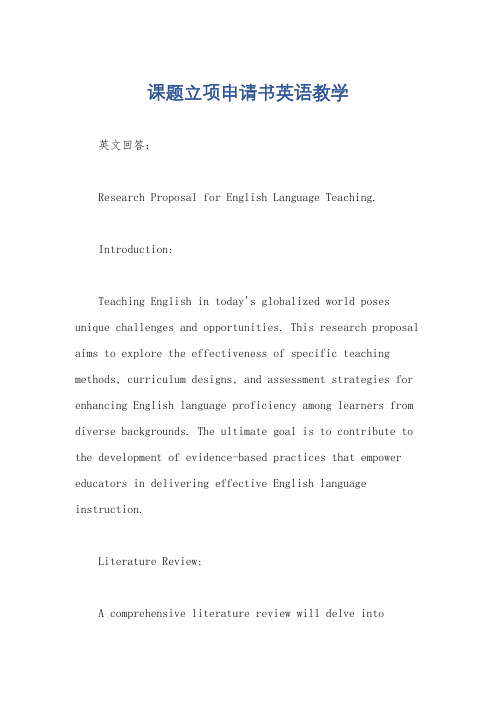
课题立项申请书英语教学英文回答:Research Proposal for English Language Teaching.Introduction:Teaching English in today's globalized world poses unique challenges and opportunities. This research proposal aims to explore the effectiveness of specific teaching methods, curriculum designs, and assessment strategies for enhancing English language proficiency among learners from diverse backgrounds. The ultimate goal is to contribute to the development of evidence-based practices that empower educators in delivering effective English language instruction.Literature Review:A comprehensive literature review will delve intoexisting research on the most effective approaches to English language teaching. This will include an examination of the cognitive, linguistic, and sociocultural factorsthat influence language acquisition. The review will also highlight the strengths and limitations of different teaching methods, from traditional grammar-translation to more interactive and communicative approaches.Research Questions:This research will investigate the following key questions:1. What teaching methods are most effective for developing learners' English language skills (reading, writing, speaking, and listening)?2. How can curriculum design be optimized to cater to the unique needs of learners from diverse linguistic and cultural backgrounds?3. What assessment strategies can accurately measurelearners' English language proficiency and provide meaningful feedback?Methodology:To answer these research questions, the study will employ a mixed-methods approach, combining bothquantitative and qualitative data collection techniques. This will include:1. Quantitative data collection: A quasi-experimental design will be used to compare the effectiveness of different teaching methods and curriculum designs. Learners will be randomly assigned to different treatment groups and their performance will be assessed using standardized language proficiency tests.2. Qualitative data collection: Observations, interviews, and focus groups will be conducted to gain insights into the experiences and perspectives of learners and teachers. This data will provide a deeper understanding of the processes involved in language acquisition and thefactors that influence learning outcomes.Expected Outcomes:This research aims to generate practical recommendations for English language teaching professionals. The expected outcomes include:1. Empirical evidence on the effectiveness of different teaching methods and curriculum designs.2. Insights into the best practices for catering to learners from diverse backgrounds.3. The development of assessment strategies that are valid, reliable, and provide actionable feedback.Significance:This research has significant implications for thefield of English language teaching. The findings will contribute to the advancement of knowledge about howlearners acquire English as a second or foreign language. By providing evidence-based recommendations, this research will empower educators to make informed decisions about their teaching practices, leading to improved learning outcomes for English language learners worldwide.中文回答:英语教学课题立项申请书。
郑州大学录取委托培养博士学位研究生协议书

郑州大学录取委托培养博士学位研究生协议书第一篇:郑州大学录取委托培养博士学位研究生协议书郑州大学录取委托培养博士学位研究生协议书郑州大学(简称甲方):委托培养单位(简称乙方):研究生(简称丙方):一、应乙方要求,甲方同意接受乙方委托培养专业博士学位研究生。
丙方录取通知书由甲方发出,培养工作由甲方负责。
二、学制: 甲方培养丙方实行以4年为基础的弹性学制(4―6年)。
三、培养要求:丙方被录取后, 甲方按照本学科、专业培养方案的要求进行培养。
四、乙方委托培养的丙方在甲方学习期间,其工资关系不转入甲方,不享受学校提供的博士研究生学业奖学金和助研奖学金。
五、学费:1、学费按照河南省发展与改革委员会审批的标准执行。
2、乙方须于新生入校报到时支付丙方的第一学年学费, 第二、三、四年学费须于每学年开学后一周内付清。
如丙方因休学、退学、开除学籍或其他原因中止学习,甲方不再退还乙方已支付的学费。
3、乙方未按时交纳学费,甲方有权对丙方按自动退学处理, 并按规定办理离校手续。
由此产生的一切责任由乙方负责, 甲方不负责善后工作。
六、丙方在甲方学习期间,应认真执行国家及学校相关管理规定,按照甲方培养方案及乙方要求完成学业,毕业后由乙方负责安排工作。
甲方负责将丙方的毕业证书、学位证书及档案材料寄至乙方, 毕业证书、学位证书由乙方转发给丙方。
如因休学、退学、开除学籍或其它原因终止学习, 按照国家有关规定处理。
七、乙方如不执行本协议, 甲方有权停止培养, 并将丙方退回乙方, 由乙方安排其工作及生活。
甲方如不执行本协议, 应赔偿乙方支付的学费。
八、本协议内容如与国家相关规定相抵触,经三方协商按照国家有关规定执行。
九、本协议一式三份, 甲、乙、丙三方各执一份。
甲方签章乙方签章丙方签名年月日****年**月**日****年**月**日第二篇:郑州大学录取委托培养博士学位研究生协议书郑州大学录取委托培养博士学位研究生协议书郑州大学(简称甲方):委托培养单位(简称乙方):研究生(简称丙方):一、应乙方要求,甲方同意接受乙方委托培养专业博士学位研究生。
郑州大学教学改革研究项目立项指南.doc

郑州大学教学改革研究项目立项指南一、综合研究本类选题侧重于研究教育教学改革的重大问题,为深化教学改革,加强教学建设,提高教学质量提供政策支持和条件保障。
1-1.各类高等学校办学指导思想、办学定位及特色办学研究;1-2.河南省高等教育布局、层次、学科(专业)结构研究;1-3.高等学校教育教学资源共享的政策、措施和运行机制研究;1-4.民办高校(独立学院、软件学院或合作办学)办学模式研究与实践;1-5.高等学校师资队伍建设研究与实践;1-6.高等学校教学团队建设的研究与实践;1-7.高等教育大众化阶段教育教学观念问题研究;1-8.大学校园文化建设研究;1-9.高等教育改革发展新形势下研究学会与教学指导委员会功能定位及建设发展研究;1-10.新时期行业特色高校发展对策研究;二、人才培养模式改革本类选题侧重于对人才培养模式的改革进行综合研究与实践,方案应突出创新特色,具有可操作性和推广价值,注重学生创新精神和创新能力的培养。
2-1.人才培养模式改革的研究与实践;2-2.人才培养方案与课程体系综合改革与实践;2-3.产学研合作教育模式探索与实践;2-4.现代远程教育人才培养模式的构建与实践;2-5.特色专业建设的研究与实践;2-6.以重点学科为依托或跨学科交叉专业建设的探索与实践;2-7.人才培养模式创新实验区建设研究与实践;2-8.高等学校专业建设规范(专业认证或专业评估)的研究与实践;三、课程教学改革本类选题侧重于课程体系与教学内容的改革,注重整体优化和整合实践,转变传统的教学观念,提高学生素质和创新能力。
3-1.各学科(专业)课程体系与教学内容改革研究与实践;3-2.各学科(专业)教材建设的研究与实践;3-3.各学科(专业)基础课教学内容、结构和体系的改革与实践;3-4.公共基础课教学内容课程体系改革的研究与实践;3-5.大学英语教学的改革与实践;3-6.精品课程建设的探索与实践;3-7.双语课程建设与实践;3-8.基于工作过程的课程开发研究与实践;四、实践教学改革本类选题侧重于改革和完善现有的实践教学体系,强化实践教学环节,保障实践教学质量,提高学生的实践动手能力。
郑州大学研究生培养方案

计算机科学与技术一级学科学术型硕士研究生培养方案1.学科名称、代码:计算机科学与技术、08122.专业与学科简介“计算机科学与技术”学科的前身是创建于1972年的郑州大学计算技术专业,是河南省最早的计算机专业,其二级学科计算机软件与理论于1992年被国家教育部批准为硕士学位授权点,是1994-1996年度和1997 -1999年度河南省重点学科,并在2000年被确定为2001-2003年度河南省第一层次重点学科,2003年再次确定为2004-2006年度河南省第一层次重点建设学科,2003年另一个二级学科计算机应用技术被确定为河南省重点学科,2006年获得计算机科学与技术一级硕士授权点和计算机软件与理论博士授权点,2008年确定计算机科学与技术为河南省一级重点学科。
经过四十年的建设和积累,该学科已具有较好的硬件条件和学术积淀,形成了一支教学经验丰富,科研实力较强,职称结构、学历结构和年龄结构比较合理的研究队伍。
3.培养目标本专业研究生必须认真学习掌握毛泽东思想、邓小平理论、“三个代表”重要思想和科学发展观,热爱祖国,品行端正,身心健康,具有自由创新精神,追求真理,献身科学教育事业的敬业精神和科学道德。
本专业以培养能在国民经济建设、科学技术发展和社会进步中发挥积极作用的开创型、复合型高层次软件与理论型专门人才为目标。
要求学生宽口径掌握坚实的基础理论和系统的专业知识并能了解计算机科学与技术的最新成果和发展方向,掌握本学科的现代先进实验方法和技能,熟练掌握一门外国语,能独立从事本专业领域的科学研究或独立承担专门技术的能力,具有较强的创新能力和实践能力,有严谨求实的科学态度和学风。
能胜任计算机科学与技术的教学、科研、软件系统开发等工作,达到《中华人民共和国学位条例》规定的硕士学位学术水平。
4.修业年限学术学位硕士研究生的基本学制为3年,申请学位最长年限为4年,即自研究生入学之日起到校学位委员会讨论通过其学位论文的时间为4年。
英语项目式学习与设计课题立项申请书

英语项目式学习与设计课题立项申请书全文共3篇示例,供读者参考篇1Title: Enhancing Environmental Awareness through Multimedia StorytellingIntroduction:In today's world, environmental issues have become increasingly pressing, and raising awareness among younger generations is crucial for creating a sustainable future. As a student passionate about multimedia and environmental conservation, I propose a project that combines these two elements through the power of storytelling.Project Overview:This project aims to develop a series of interactive multimedia stories that educate and engage audiences, particularly young people, on critical environmental topics such as climate change, biodiversity loss, and sustainable living practices. By leveraging the immersive and captivating nature of multimedia storytelling, we can create a compelling andeducational experience that resonates with a wide range of audiences.Rationale:Traditional methods of environmental education often rely on textbooks, lectures, or static visual aids, which may not effectively capture the attention and interest of today's digitally native generations. Multimedia storytelling, on the other hand, offers a unique opportunity to convey complex environmental concepts in an engaging and visually appealing manner, making the content more accessible and relatable.By incorporating elements such as animations, interactive scenarios, and gamified learning experiences, we can create a dynamic and participatory learning environment that encourages active engagement and fosters a deeper understanding of environmental issues.Project Goals:Develop a series of five interactive multimedia stories, each focusing on a specific environmental topic (e.g., climate change, deforestation, ocean pollution, biodiversity loss, and sustainable living practices).Incorporate immersive visuals, animations, and interactive elements to create an engaging and educational experience.Collaborate with subject matter experts, environmental organizations, and multimedia professionals to ensure accuracy and authenticity.Pilot the multimedia stories in local schools and community centers, gathering feedback and data on their effectiveness in raising environmental awareness and influencing behavior.Develop a comprehensive lesson plan and teaching resources to accompany the multimedia stories, ensuring seamless integration into educational curricula.Create a dedicated website or online platform to host and disseminate the multimedia stories, making them accessible to a global audience.Project Methodology:Research and Content Development:Conduct extensive research on the selected environmental topics, collaborating with subject matter experts and environmental organizations.Develop compelling narratives and storylines that effectively communicate key concepts and inspire positive action.Gather authentic data, statistics, and visual assets to enhance the credibility and impact of the stories.Multimedia Production:Assemble a team of multimedia professionals, including animators, graphic designers, and interactive developers.Leverage industry-standard tools and software for animation, interactive design, and multimedia integration.Develop immersive visuals, animations, and interactive elements that bring the stories to life.Incorporate gamification elements and interactive scenarios to enhance engagement and reinforce learning.Pilot and Evaluation:Collaborate with local schools and community centers to pilot the multimedia stories with target audiences.Conduct pre- and post-assessments to measure the effectiveness of the stories in raising environmental awareness and influencing behavior.Gather feedback from participants, educators, and subject matter experts to refine and improve the multimedia stories.Dissemination and Outreach:Develop a dedicated website or online platform to host and disseminate the multimedia stories, ensuring accessibility to a global audience.Establish partnerships with educational institutions, environmental organizations, and media platforms to promote and distribute the multimedia stories.Conduct workshops and training sessions for educators and facilitators to effectively integrate the multimedia stories into their curricula or programs.Expected Outcomes and Impact:Through this project, we aim to create a powerful and engaging educational resource that not only raises awareness about critical environmental issues but also inspires positive action and behavioral change. By leveraging the power of multimedia storytelling, we can effectively communicate complex concepts in a way that resonates with diverse audiences, particularly younger generations.The immersive and interactive nature of the multimedia stories will foster a deeper understanding and emotional connection to environmental challenges, ultimately empowering individuals to become active agents of change in their communities and beyond.Furthermore, by collaborating with subject matter experts, environmental organizations, and multimedia professionals, we ensure the accuracy and authenticity of the content, while also contributing to the broader discourse on environmental education and sustainability.Conclusion:This project represents a unique and innovative approach to environmental education, harnessing the power of multimedia storytelling to inspire and empower individuals to take action towards a more sustainable future. By combining compelling narratives, immersive visuals, and interactive elements, we can create a transformative educational experience that leaves a lasting impact on audiences worldwide.篇2Title: Proposing an English Project-Based Learning InitiativeIntroduction:As a student who has spent years studying English through traditional methods, I have come to realize the limitations of rote memorization and rigid curriculums. While these approaches may impart a certain level of proficiency, they often fail to cultivate the practical skills and genuine enthusiasm necessary for true language mastery. It is with this realization that I humbly propose an innovative, project-based learning initiative for English education.The Rationale:Language is a living, breathing entity that thrives through authentic expression and real-world application. By embracing project-based learning, we can transcend the confines of the classroom and engage with English in a more organic, meaningful way. This approach not only enhances language acquisition but also fosters critical thinking, creativity, and collaboration – skills that are invaluable in our increasingly interconnected world.The Proposal:The proposed initiative would involve the integration of project-based learning into the English curriculum, beginning at the secondary school level. Students would be tasked withconceiving, developing, and executing various projects that require the practical application of their English skills.These projects could range from creating a school newsletter or blog, organizing a cultural exchange program, crafting and performing a play or skit, designing and implementing a community service initiative, or even launching a small business venture. The possibilities are endless, and the key lies in allowing students to explore their interests while leveraging their English proficiency.Pedagogical Approach:The project-based learning approach would be underpinned by the following principles:Student-Centered Learning: Students would take an active role in shaping their learning experience, with teachers serving as facilitators and mentors. This approach fosters ownership, motivation, and a deeper engagement with the subject matter.Authentic Tasks: Projects would be designed to mirrorreal-world scenarios, requiring students to grapple with authentic challenges and communicate effectively in English. This approach bridges the gap between classroom learning and practical application.Collaborative Learning: Projects would encourage collaboration among students, fostering teamwork, communication skills, and the ability to navigate diverse perspectives – all vital competencies in today's globalized world.Interdisciplinary Integration: English projects would intersect with other subject areas, such as history, science, art, and technology, promoting a more holistic and interconnected understanding of knowledge.Reflection and Evaluation: Students would engage in ongoing self-reflection and peer-evaluation, developing metacognitive skills and the ability to provide constructive feedback – invaluable assets for lifelong learning.Implementation and Logistics:The successful execution of this initiative would require a collaborative effort from various stakeholders, including:Curriculum Development: A dedicated team of educators, subject matter experts, and curriculum designers would be assembled to develop project-based learning modules and integrate them seamlessly into the existing English curriculum.Teacher Training: Professional development programs would be implemented to equip teachers with the necessaryskills and strategies to facilitate project-based learning effectively.Resource Allocation: Adequate resources, such as technology infrastructure, project materials, and dedicated spaces for collaboration, would need to be allocated to support the initiative.Community Engagement: Partnerships with local organizations, businesses, and community groups would be established to provide real-world contexts for projects and foster authentic learning experiences.Assessment and Evaluation: A comprehensive assessment framework would be developed to measure student progress, project outcomes, and the overall effectiveness of the initiative, allowing for continuous improvement and refinement.Anticipated Benefits:The implementation of this project-based learning initiative for English education would yield numerous benefits for students, educators, and the broader community:Improved Language Proficiency: By engaging with English in authentic, meaningful contexts, students would develop adeeper understanding and mastery of the language, enhancing their communication skills and confidence.Transferable Skills Development: Projects would cultivate a range of transferable skills, including critical thinking,problem-solving, creativity, collaboration, and digital literacy –skills that are highly valued in both academic and professional settings.Increased Motivation and Engagement: When students are empowered to pursue their interests and take ownership of their learning, they tend to exhibit greater motivation, engagement, and a genuine passion for their studies.Preparedness for Future Challenges: By fostering adaptability, resilience, and the ability to navigate ambiguity, project-based learning would equip students with the essential skills to thrive in an ever-changing, globally connected world.Community Impact: Through community partnerships and service-oriented projects, this initiative would foster stronger connections between educational institutions and the broader community, contributing to positive social change.Conclusion:The proposed English project-based learning initiative represents a paradigm shift in language education, one that prioritizes authentic learning experiences, student agency, and the cultivation of transferable skills. By embracing this approach, we can nurture a generation of lifelong learners who possess not only linguistic proficiency but also the intellectual curiosity, creativity, and adaptability to navigate the complexities of our modern world.I firmly believe that this initiative has the potential to revolutionize the way we approach English education, empowering students to become confident communicators, critical thinkers, and globally-minded citizens. With the support and collaboration of educators, administrators, and the broader community, we can create a dynamic, engaging learning environment that truly prepares our students for the challenges and opportunities of the 21st century.篇3Project-Based Learning and Design Topic Proposal: Sustainable Urban Gardening SolutionsIntroductionAs a passionate advocate for environmental sustainability and urban agriculture, I am thrilled to propose a project that combines these two critical areas. Rapid urbanization and the growing demand for fresh, locally sourced produce have highlighted the need for innovative solutions that can bring agriculture into cities. Through this project, I aim to design and implement sustainable urban gardening strategies that not only promote food security but also contribute to the overallwell-being of urban communities.Background and RationaleUrban areas are often faced with challenges such as limited green spaces, soil contamination, and a lack of access to fresh, nutritious food. These issues disproportionately affectlow-income communities, exacerbating health disparities and food insecurity. Furthermore, traditional agriculture practices can have significant environmental impacts, contributing to greenhouse gas emissions, water pollution, and soil degradation.Project-based learning provides an ideal framework for addressing these complex challenges. By applying theoretical knowledge to real-world situations, students can develop critical thinking, problem-solving, and collaboration skills while simultaneously contributing to their communities. This projectaims to bridge the gap between academia and practical application, fostering a deeper understanding of sustainable urban agriculture practices.Project ObjectivesConduct a comprehensive assessment of the current state of urban agriculture in the local community, identifying opportunities, challenges, and best practices.Design and implement sustainable urban gardening solutions that address food insecurity, promote environmental stewardship, and enhance community engagement.Develop educational resources and workshops to empower community members with the knowledge and skills necessary for successful urban gardening initiatives.Foster partnerships and collaborations with local organizations, businesses, and government agencies to ensure the long-term sustainability and scalability of the project.Evaluate the project's impact on food security, environmental sustainability, and community well-being through quantitative and qualitative measures.Project MethodologyThe project will employ a participatory approach, actively involving community members, local stakeholders, and experts in the design and implementation process. This collaborative effort will ensure that the solutions are tailored to the unique needs and cultural contexts of the urban environment.Phase 1: Community Assessment and Stakeholder EngagementConduct surveys, focus groups, and interviews to gather data on the community's needs, preferences, and existing initiatives related to urban agriculture.Identify key stakeholders, including community organizations, local businesses, and government agencies, and engage them in the project planning process.Assess the availability of resources, such as vacant lots, rooftops, and underutilized spaces, that can be repurposed for urban gardening.Phase 2: Design and ImplementationDevelop sustainable urban gardening strategies, such as vertical farming, rooftop gardens, community gardens, and hydroponic systems, based on the community assessment and stakeholder input.Implement pilot projects to test and refine the proposed solutions, incorporating feedback from community members and experts.Establish partnerships with local organizations and businesses to secure resources, including funding, materials, and technical expertise.Phase 3: Education and OutreachCreate educational materials, including instructional videos, workshops, and hands-on training sessions, to empower community members with urban gardening skills.Collaborate with local schools and community centers to integrate urban agriculture education into their curricula and programs.Develop a comprehensive marketing and outreach strategy to raise awareness about the project and promote community engagement.Phase 4: Monitoring and EvaluationEstablish quantitative and qualitative measures to evaluate the project's impact on food security, environmental sustainability, and community well-being.Conduct regular assessments and gather feedback from stakeholders to identify areas for improvement and ensure the project's long-term viability.Disseminate the project's findings and best practices through academic publications, conferences, and online platforms, contributing to the broader discourse on sustainable urban agriculture.Expected Outcomes and ImpactThis project has the potential to create a ripple effect of positive change within urban communities. By promoting sustainable urban gardening practices, we can address food insecurity, improve access to fresh and nutritious produce, and enhance community resilience. Additionally, the project will contribute to environmental sustainability by reducing greenhouse gas emissions, promoting biodiversity, and creating green spaces within urban areas.Furthermore, the educational and outreach components of the project will empower community members with valuable skills and knowledge, fostering a sense of ownership and pride in their local food systems. This, in turn, can strengthen social cohesion, promote intergenerational learning, and createopportunities for economic development through urban agriculture initiatives.ConclusionThis project represents a holistic approach to addressing the complex challenges faced by urban communities, while simultaneously promoting environmental sustainability and food security. Through a collaborative and participatory process, we can design and implement innovative solutions that not only meet the immediate needs of the community but also contribute to long-term resilience and well-being.I am confident that this project will not only enrich my academic journey but also create a lasting impact on the local community. With the support and guidance of faculty members, industry experts, and community partners, we can collectively pave the way for a more sustainable and equitable future for urban areas.。
郑州大学研究生全英语教学课程立项协议书

竭诚为您提供优质文档/双击可除郑州大学研究生全英语教学课程立项协议书
郑州大学研究生全英语教学课程立项协议书
郑州大学研究生全英语教学课程立项协议书
甲方:郑州大学研究生院乙方:课程负责人
第三方:课程负责人所在院系
1、为营造研究生的全英语培养环境,加快我校学位与研究生教育的国际化进程,培养具有国际视野的高质量创新型人才,给予研究生全英语教学课程立项资助。
课程名称:
课程编号:
2、课程资助总金额为5万元,本协议签订后,甲方向乙方先划拨2.5万元,学校将在课程建设的第二年进行中期评估与验收,验收合格,下拨剩余资助经费;不合格,须对课程建设进行整改,整改效果明显的下拨剩余资助经费,整改效果不明显的将不再资助。
3、乙方保证根据课程计划书,如期提供课程建设的预期成果。
4、本课程资助自协议签订之日起,3年内完成,课程建设完成后乙方向甲方提供全英语教学课程结项报告和有关材料的原件及复印件。
5、本协议一式三份,甲乙方各留一份,乙方所在院系留存一份。
6、第三方负责督促乙方完成课程建设任务,必要时给予支持与协助。
研究生精品课程建设立项

郑州航空工业管理学院
研究生优质课程建设项目结项报告表
推荐单位
课程名称
所属一级学科名称
课程负责人
申请日期
郑州航院研究生处制
填表说明
1、本表用word文档填写。
2、申报人应认真填写表中的每一项,内容准确、清晰、详实。
3、内容较多无法按表填写时,可增加附页。
4、本表栏目未涵盖的内容,需要说明的,请在附页中注明。
5、本申请书一式3份,A4纸单面打印。
6、以下材料需连同此报告表一同提供:
(1)研究内容报告(不少于1万字);
(2)课程建设规划;
(3)新增的课程资源,包括:教学大纲、选定或出版的教材、教学辅助资料、教学参考资料、课程资源网站等;(4)获得与课程相关的各类成果证明;
(5)本项目的经费开支(财务处的项目收支明细账页)。
研究生教育教学改革研究项目立项申请书【模板】

年龄
职称
专业
分工情况
项目简介
项目简介不超过1000字、一页A4纸,应包含以下四部分内容:
1.拟主要解决的研究生教育实践问题
2.解决实践问题的方法
3.主要创新点
4.预期成果推广应用价值及贡献
立项依据
立项依据不超过5000字,应包含以下内容:
项目研究的目的、意义;研究的主要内容、关键问题与创新思路;研究的方案与措施;研究的可行性分析;年度进展计划与预期成果;申请的经费及主要使用途径等。
所在单位推荐审查意见:
负责人签字: (公章)
年 月 日
评审专家小组意见:
组长签字:
年 月 日
研究生院意见:
负责人: (公章)
年 月 日
注:本表一式两份,用A4纸双面打印,交至研究生院培养办公室(长安校区文汇楼A段517室)。
编号
研究生教育教学改革研究项目
立项申请书
(教育实践类)
项目名称
申请单位
项目负责人
联系电话
电子信箱
申请日期
**大学研究生院制
2017年1月
填 表 说 明
1.项目编号由研究生院统一填写
2.项目名称:字数(含符号)不超过35个汉字
3.项目起止时间指研究时间
4.申请书用A4双面打印,正文内容应不小于四号字。需签字、盖章处打印或复印无效。
研
究
课
题
名称
起止时间
年月至年月
项目类别
□教育教学改革与研究
□ 定向资助
项
目
负
责
人
姓名
性别
出生年月职称学历Fra bibliotek位专业领域
联系电话
学科教学(英语)专业研究生立项申报书

学科教学(英语)专业研究生立项申报书学科教学(英语)专业研究生立项申报书是指在申请研究生立项过程中所需提交的申请书,旨在介绍研究生的研究课题,阐述其研究意义、研究目的和研究方法,以及相关的研究经费、时间和组织管理等方面的计划。
具体来说,学科教学(英语)专业研究生立项申报书通常包括以下内容:
1. 立项背景:介绍选题的背景和意义,阐述该课题目前的研究情况以及存在的问题和研究价值。
2. 研究目的:明确研究目的,阐述解决问题的实际意义,提出具体的研究问题和研究假设。
3. 研究方法:介绍研究的理论基础和方法,包括研究范围、研究采用的方法、数据来源和处理方法等。
4. 研究进度和时间计划:详细阐明研究的时间安排和工作计划,以及完成各项研究任务的时间节点。
5. 研究经费:对所需的研究费用和经费来源进行详细说明,包括研究所需的设备、材料、实验费用以及人员开支等。
6. 研究组织管理:阐述研究组织机构和管理方式,确保研究任务的顺利开展和管理。
总之,学科教学(英语)专业研究生立项申报书是研究生在选择课题和进行科学研究前需要准备的重要材料,通过合理的撰写,可以为研究生立项申请的成功提供有效的支持和帮助。
英语课题立项申请书范文
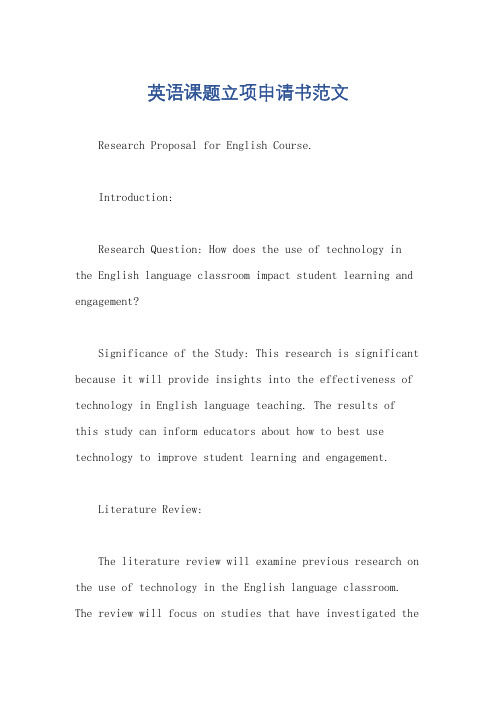
英语课题立项申请书范文Research Proposal for English Course.Introduction:Research Question: How does the use of technology in the English language classroom impact student learning and engagement?Significance of the Study: This research is significant because it will provide insights into the effectiveness of technology in English language teaching. The results ofthis study can inform educators about how to best use technology to improve student learning and engagement.Literature Review:The literature review will examine previous research on the use of technology in the English language classroom. The review will focus on studies that have investigated theimpact of technology on student learning, engagement, and motivation.Methodology:The research will use a mixed-methods approach. Quantitative data will be collected through surveys and questionnaires. Qualitative data will be collected through interviews and observations.Data Analysis:The quantitative data will be analyzed usingstatistical software. The qualitative data will be analyzed using thematic analysis.Expected Outcomes:The expected outcomes of this research are:1. A better understanding of the impact of technology on student learning and engagement in the English languageclassroom.2. Recommendations for how to best use technology inthe English language classroom.Timeline:The research will be conducted over a period of one year. The research will be completed by the end of May 2024.Budget:The budget for this research is $5,000. The budget will be used to cover the costs of data collection, data analysis, and dissemination of results.References:[1] Egbert, J., & Petrie, H. (2013). Technology in the language classroom: A literature review. Language Teaching Research, 17(2), 193-215.[2] Warschauer, M., & Matuchniak, T. (2010). New technologies and second language learning. Annual Review of Applied Linguistics, 30, 24-45.中文回答:研究课题申请书。
- 1、下载文档前请自行甄别文档内容的完整性,平台不提供额外的编辑、内容补充、找答案等附加服务。
- 2、"仅部分预览"的文档,不可在线预览部分如存在完整性等问题,可反馈申请退款(可完整预览的文档不适用该条件!)。
- 3、如文档侵犯您的权益,请联系客服反馈,我们会尽快为您处理(人工客服工作时间:9:00-18:30)。
郑州大学研究生全英语教学课程立项协议书甲方:郑州大学研究生院
乙方:课程负责人
第三方:课程负责人所在院系
1、为营造研究生的全英语培养环境,加快我校学位与研究生教育的国际化进程,培养具有国际视野的高质量创新型人才,给予研究生全英语教学课程立项资助。
课程名称:
课程编号:
2、课程资助总金额为5万元,本协议签订后,甲方向乙方先划拨2.5万元,学校将在课程建设的第二年进行中期评估与验收,验收合格,下拨剩余资助经费;不合格,须对课程建设进行整改,整改效果明显的下拨剩余资助经费,整改效果不明显的将不再资助。
3、乙方保证根据课程计划书,如期提供课程建设的预期成果。
4、本课程资助自协议签订之日起,3年内完成,课程建设完成后乙方向甲方提供全英语教学课程结项报告和有关材料的原件及复印件。
5、本协议一式三份,甲乙方各留一份,乙方所在院系留存一份。
6、第三方负责督促乙方完成课程建设任务,必要时给予支持与协助。
甲方签章:
年月日乙方负责人:
年月日
第三方负责人签章:
年月日
附件:郑州大学研究生全英语教学课程计划书
郑州大学研究生全英语教学课程计划书
1、课程名称:
2、课程编号:
3、全英语教学授课模式
4、课程建设进度计划(含预期目标和阶段成果)
5、课程建设负责人和组成人员简况
6、课程负责人签字
年月日
7、院系负责人签字(公章)
年月日。
